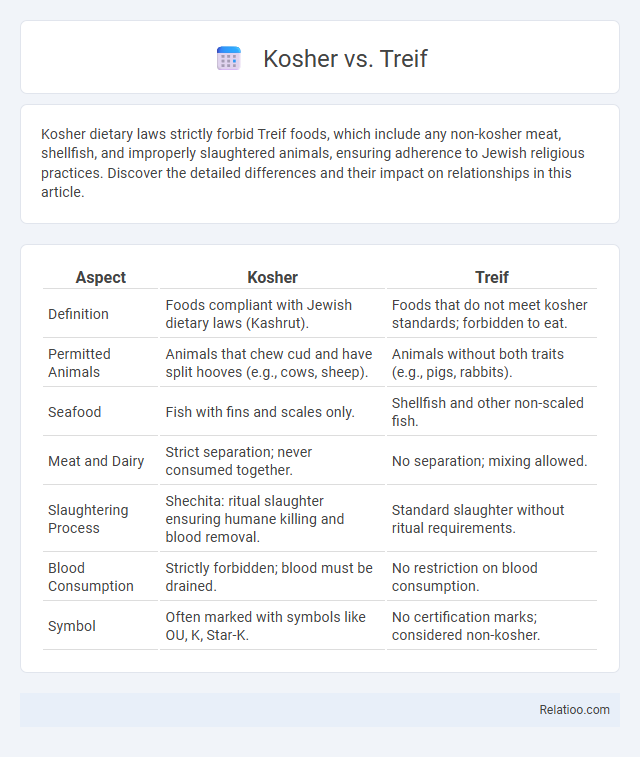Kosher dietary laws strictly forbid Treif foods, which include any non-kosher meat, shellfish, and improperly slaughtered animals, ensuring adherence to Jewish religious practices. Discover the detailed differences and their impact on relationships in this article.
Table of Comparison
| Aspect | Kosher | Treif |
|---|---|---|
| Definition | Foods compliant with Jewish dietary laws (Kashrut). | Foods that do not meet kosher standards; forbidden to eat. |
| Permitted Animals | Animals that chew cud and have split hooves (e.g., cows, sheep). | Animals without both traits (e.g., pigs, rabbits). |
| Seafood | Fish with fins and scales only. | Shellfish and other non-scaled fish. |
| Meat and Dairy | Strict separation; never consumed together. | No separation; mixing allowed. |
| Slaughtering Process | Shechita: ritual slaughter ensuring humane killing and blood removal. | Standard slaughter without ritual requirements. |
| Blood Consumption | Strictly forbidden; blood must be drained. | No restriction on blood consumption. |
| Symbol | Often marked with symbols like OU, K, Star-K. | No certification marks; considered non-kosher. |
Introduction to Kosher and Treif
Kosher refers to food that complies with Jewish dietary laws outlined in the Torah, specifying permissible animals, slaughter methods, and food preparation rules, whereas Treif denotes food that is non-kosher or forbidden, such as pork and shellfish. These dietary laws are integral to Jewish culture and identity, emphasizing ritual purity, ethical animal treatment, and separation of meat and dairy products. Understanding the distinctions between Kosher and Treif offers insight into broader food taboos rooted in religious, cultural, and health considerations across societies.
Historical Origins of Kosher Laws
Kosher dietary laws originate from ancient Jewish texts, primarily the Torah, where specific animals and food preparation methods are prescribed for religious purposes. These laws distinguish permissible (kosher) from forbidden (treif) foods, shaping Jewish culture and identity across centuries. Food taboos in many cultures, including kosher laws, historically serve to establish social boundaries and maintain spiritual purity.
Core Differences: Kosher vs Treif
Kosher and Treif are terms defining permissible and forbidden foods according to Jewish dietary laws, with Kosher referring to foods that comply with kashrut rules and Treif indicating foods that violate these laws. Key distinctions include the types of animals allowed, such as kosher mammals that chew cud and have split hooves versus non-kosher animals included in Treif, and the prohibition of mixing meat and dairy in Kosher practices, whereas Treif foods may violate these separation rules. The certification process and ritual slaughter methods also mark core differences, with Kosher food requiring specific shechita practices and Treif lacking such standards, reflecting fundamental religious and cultural dietary taboos.
Key Kosher Animal and Food Guidelines
Kosher dietary laws specify key animals that are permitted for consumption, including mammals that chew their cud and have split hooves, such as cows and sheep, as well as fish with fins and scales like salmon. Treif refers to non-kosher foods that violate these guidelines, including pork, shellfish, and mixing meat with dairy. Food taboos extend beyond kosher laws, encompassing cultural and religious prohibitions that influence dietary customs and food selection worldwide.
Prohibited Treif Foods and Ingredients
Prohibited Treif foods include pork and shellfish, both strictly forbidden in kosher dietary laws due to their unclean classification, alongside any meat from animals that do not chew their cud or have split hooves, such as rabbits and horses. Your consumption of Treif foods also encompasses products contaminated by non-kosher ingredients like gelatin derived from forbidden animals or certain animal-based emulsifiers. Understanding these taboos ensures adherence to kosher standards by avoiding all substances considered impure or non-kosher in food preparation and consumption.
Kosher Certification and Standards
Kosher certification ensures that Your food complies with strict Jewish dietary laws, involving a detailed inspection of ingredients, food preparation, and equipment to avoid any contamination with treif, or non-kosher foods. Kosher standards are enforced by certified organizations that verify adherence through continuous supervision, guaranteeing the food's suitability for consumption under Jewish law. Understanding food taboos like treif highlights the importance of kosher certification in maintaining dietary purity and respecting cultural and religious practices.
Common Misconceptions About Kosher
Common misconceptions about kosher food include the belief that kosher simply means vegetarian or that it guarantees organic quality; in reality, kosher laws strictly regulate animal slaughter, food preparation, and ingredient sourcing according to Jewish dietary law. Kosher differs fundamentally from treif, which refers to non-kosher foods including pork and shellfish that are forbidden in Judaism due to specific Torah prohibitions. Unlike general food taboos found across cultures, kosher regulations encompass detailed rituals and certification processes verified by rabbinical authorities to ensure compliance.
Health Implications of Kosher and Treif Diets
Kosher diets, adhering to Jewish dietary laws, emphasize cleanliness and the avoidance of certain animals and improper food combinations that may reduce exposure to contaminants and parasites. Treif diets, consisting of non-kosher foods, may increase risks related to zoonotic diseases and foodborne illnesses due to consumption of prohibited species and uninspected animal products. Food taboos universally impact health by limiting or encouraging diets that affect nutritional balance, microbial exposure, and immune system responses.
Cultural Significance in Jewish Life
Kosher dietary laws, deeply rooted in Jewish tradition, define permissible foods and preparation methods, symbolizing spiritual discipline and identity. In contrast, treif refers to non-kosher foods that violate these sacred laws, representing boundaries between the sacred and the profane. Your adherence to these food taboos reflects a connection to cultural heritage, community cohesion, and religious observance within Jewish life.
Conclusion: Choosing Between Kosher and Treif
Choosing between kosher and treif foods impacts your dietary practices based on religious and cultural adherence. Kosher foods comply with Jewish dietary laws, emphasizing ritual purity and specific animal slaughtering methods, while treif refers to foods that violate these laws and are forbidden for consumption. Understanding these distinctions ensures your food choices align with spiritual values and community traditions.

Infographic: Kosher vs Treif
 relatioo.com
relatioo.com